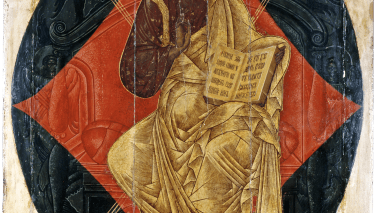In 1439 Abraham of Souzdal, a Russian bishop visiting Florence, was in the audience in Santa Maria del Carmine for the famous Ascension play, arranged by the members of the lay confraternity, the Sant’Agnese. Sitting in the body of the church, Abraham looked up and saw, on top of one end of the huge stone choir screen, a castle with towers and ramparts, and at the other a Mount of Olives. From here the ascending Christ was drawn up through celestial curtains to be united with God the Father, suspended ‘in a miraculous fashion’ in the far distance above the altar. Invisible ropes and pulleys and visible local children, ‘who represent angels with pipes and lutes and lots of tiny bells’, contributed to a spectacle that had been performed annually for at least 50 years.
It is a wonderfully evocative vignette, a glimpse into another world, and its place in Painted Glories is characteristic of Nicholas Eckstein’s oblique approach to one of the greatest treasures of the Florentine renaissance. The Brancacci chapel, with its frescoes painted in the mid-1420s by Masolino and Masaccio, and finished some 60 years later by Filippino Lippi, has frustrated generations of art historians with its lack of documentary evidence that might help pin down who did what and when. Scientific analysis has gone some way to fill in the gaps, but speculation has inevitably been a feature of many studies over the last decades. Eckstein has chosen a different course. The significance of the frescoes in the history of western art is taken for granted, and instead he looks at the chapel in the context of the social, religious and historical life of the church and the community it served.
Contemporary context is particularly important in relation to these paintings, stranded as they are in a time-capsule in the west transept of a church otherwise entirely remodelled inside after a devastating fire in the 18th century.








Comments
Join the debate for just £1 a month
Be part of the conversation with other Spectator readers by getting your first three months for £3.
UNLOCK ACCESS Just £1 a monthAlready a subscriber? Log in